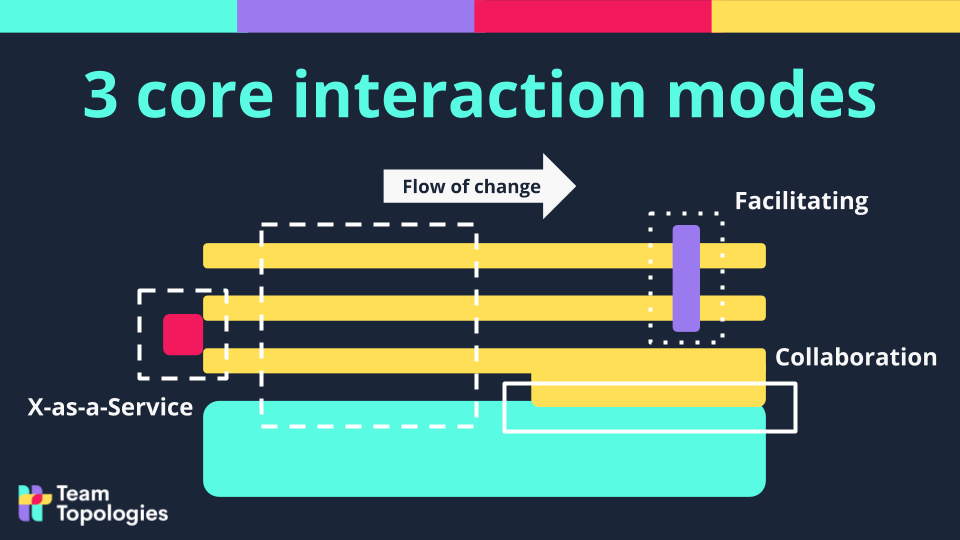Interaction Modes
Overview¶
Interaction modes within the Team Topologies framework are essential for defining how teams engage and collaborate. These modes are strategic approaches to communication and collaboration designed to optimize the flow of information and work across your organization. The three primary interaction modes are Collaboration, X-as-a-Service, and Facilitating. By understanding and effectively implementing these modes, you can significantly enhance the efficiency and effectiveness of your inter-team interactions, contributing to a smoother software delivery process and a more adaptable organization.

Collaboration¶
Purpose: Collaboration is about working closely together towards a common goal, often involving two or more teams that join forces for a defined period to solve problems, design solutions, or achieve a specific outcome.
Characteristics:
- Temporary and intensive interaction focused on a specific project or challenge.
- Shared responsibility for the outcome, with all parties actively contributing ideas, feedback, and solutions.
- Often facilitated through workshops, pair programming, cross-team meetings, and other joint activities.
Benefits:
- Generates innovative solutions by combining diverse perspectives and expertise.
- Builds stronger relationships and understanding between teams, improving future interactions.
- Accelerates learning and knowledge transfer across the organization.
X-as-a-Service¶
Purpose: The X-as-a-Service mode defines a relationship in which one team provides a service (X) that other teams consume. This model operates similarly to external cloud services, emphasizing clear interfaces, documentation, and self-service capabilities.
Characteristics:
- The providing team focuses on the service's reliability, scalability, and usability, ensuring it meets the needs of consuming teams.
- Consuming teams access the service through well-defined interfaces, with minimal direct interaction with the providing team.
- Emphasis on automation and self-service to reduce dependencies and improve efficiency.
Benefits:
- Enhances autonomy by allowing teams to access and use services independently.
- Reduces bottlenecks and wait times associated with requesting and receiving support.
- Promotes scalability and reliability through standardized service offerings.
Facilitating¶
Purpose: Facilitating interaction mode is about one team helping another overcome obstacles, improve practices, or develop new capabilities. This is often the role of Enabling Teams, which focus on upskilling and empowering other teams rather than delivering direct contributions to products or services.
Characteristics:
- Targeted support provided through mentoring, coaching, training sessions, and sharing of best practices.
- Temporary engagement with the goal of transferring knowledge and skills rather than long-term collaboration.
- Focus on enabling the receiving team to become self-sufficient in a particular area of expertise.
Benefits:
- Accelerates the development of new capabilities within teams, improving overall organizational competence.
- Reduces future dependencies on external teams to solve similar problems.
- Fosters a culture of continuous improvement and learning.
Understanding and applying these interaction modes allows organizations to effectively manage dependencies, streamline communication, and enhance collaboration across teams. By aligning team interactions with strategic goals, organizations can create a dynamic and responsive structure that supports rapid innovation and delivery, ultimately leading to greater business agility and success.